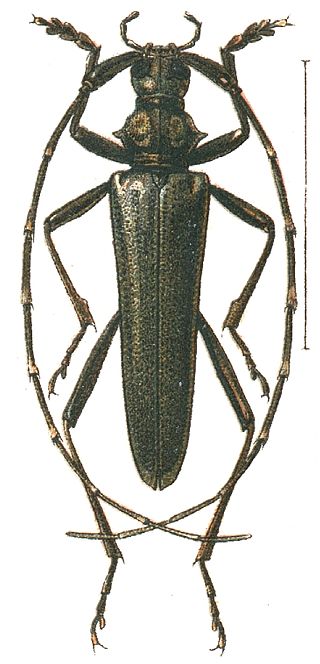Michael S. Engel, FLS, FRES was an American paleontologist and entomologist, notable for contributions to insect evolutionary biology and classification. In connection with his studies he undertook field expeditions in Central Asia, Asia Minor, the Levant, Arabia, eastern Africa, the high Arctic, and South and North America, and published more than 925 papers in scientific journals. Some of Engel's research images were included in exhibitions on the aesthetic value of scientific imagery.

Pleocoma is the only extant genus of rain beetles and is endemic to the Pacific states of North America. Fossil remains of Pleocoma have been found in the Yixian Formation in China, suggesting beetles in this genus have existed in something like their present form since at least the Cretaceous period. There are 27 described species in Pleocoma.

The Disteniidae are a small family of beetles in the superfamily Chrysomeloidea, traditionally treated as a group within the Cerambycidae.

Clytini is a tribe of beetles in the subfamily Cerambycinae, containing the following genera:

Parevander xanthomelas is a species of beetle in the family Cerambycidae. It was described by Félix Édouard Guérin-Méneville in 1844, and has been classified in the genus Parevander since the circumscription of that genus by Per Olof Christopher Aurivillius in 1912.
Hyptia deansi is an extinct species of ensign wasp in the family Evaniidae known from a solitary Late Oligocene to Early Miocene fossil found in Mexico. H. deansi is the only species in the genus Hyptia to have been described from fossils and the only ensign wasp described from Mexican amber.
Mastotermes electromexicus is an extinct species of termite in the family Mastotermitidae known from a group of Late Oligocene to Early Miocene fossils found in Mexico. M. electromexicus is the only species in the genus Mastotermes to have been described from fossils found in Mexican amber and was the first member of the genus described from the New World. The only living species of Mastotermes is Mastotermes darwiniensis which is found in tropical regions of Northern Australia.
Termitaradus protera is an extinct species of termite bug in the family Termitaphididae known from several Late Oligocene to Early Miocene fossils found in Mexico. T. protera is the only species in the extant genus Termitaradus to have been described from fossils found in Mexican amber and is one of four species from new world amber; the others are Termitaradus avitinquilinus, Termitaradus dominicanus and Termitaradus mitnicki. T. protera was also the first termite bug described from the fossil record.
Hymenaea mexicana is an extinct legume species in the family Fabaceae described from a series of isolated fossil petals, leaflets, and amber. The species is known from a group of Late Oligocene to Early Miocene locations in southern Mexico. It is one of two extinct Hymenaea species placed close to the living species Hymenaea verrucosa and along with Hymenaea allendis, is one of the two extinct species which have been found in Mexican amber.
Hymenaea allendis is an extinct legume species in the family Fabaceae described from a single isolated fossil flower in amber. The species is known from a Late Oligocene to Early Miocene location in southern Mexico. Unlike the coeval extinct species Hymenaea mexicana and Hymenaea protera which are placed closer to the living species Hymenaea verrucosa of Africa, H. allendis is closer in relation to the neotropical species of Hymenaea.
Aphaenogaster praerelicta is an extinct species of ant in the subfamily Myrmicinae known from a solitary Late Oligocene to Early Miocene fossil found in Mexico. At the time of description A. praerelicta was one of three Aphaenogaster species known from Mexico.
Dicromantispa electromexicana is an extinct species of mantidfly in the neuropteran family Mantispidae known from a fossil found in North America.
Dicromantispa moronei is an extinct species of mantidfly in the neuropteran family Mantispidae known from a fossil found in the Caribbean.
Leptopharsa tacanae is an extinct species of lace bug in the family Tingidae. The species is solely known from the Late Oligocene to Middle Miocene Mexican amber deposits. The species is the first lace bug described from Mexican amber.

Tityus apozonalli is an extinct species of scorpion in the family Buthidae known from a fossil found in North America. The species is one of two scorpions described from Mexican amber and one of seven species from Central American amber deposits.

Maatidesmus is an extinct genus of millipede in the family Chelodesmidae known from a fossil found in North America. There is one described species in the genus, Maatidesmus paachtun, one of three millipedes described from Mexican amber.

Mexican amber, also known as Chiapas Amber is amber found in Mexico, created during the Early Miocene and middle Miocene epochs of the Cenozoic Era in southwestern North America. As with other ambers, a wide variety of taxa have been found as inclusions including insects and other arthropods, as well as plant fragments and epiphyllous fungi.
Callistola is a genus of leaf beetles in the tribe Cryptonychini. Species in this genus are found in the Pacific region, with a large number of species known from New Guinea.
Gressittana is a genus of leaf beetles in the subfamily Eumolpinae. It contains only one species, Gressittana sculpturata, which was originally placed in Rhyparida. The genus is endemic to New Guinea, and is named after Judson Linsley Gressitt.

Judson Linsley Gressitt was an American entomologist and naturalist who worked in Japan and China. He worked mainly on beetle diversity in Southeast Asia and in applied areas, particularly medical entomology, and was the founder of the journal Pacific Insects and the Wau Ecology Institute in Papua New Guinea. Apart from insects, he collected specimens in numerous taxa and several have been named after him.







